PERFECT PROTEIN PAIRINGS
SALADS FOR COWS
DAIRY FARMER SUMMITS WORLD’S PEAKS



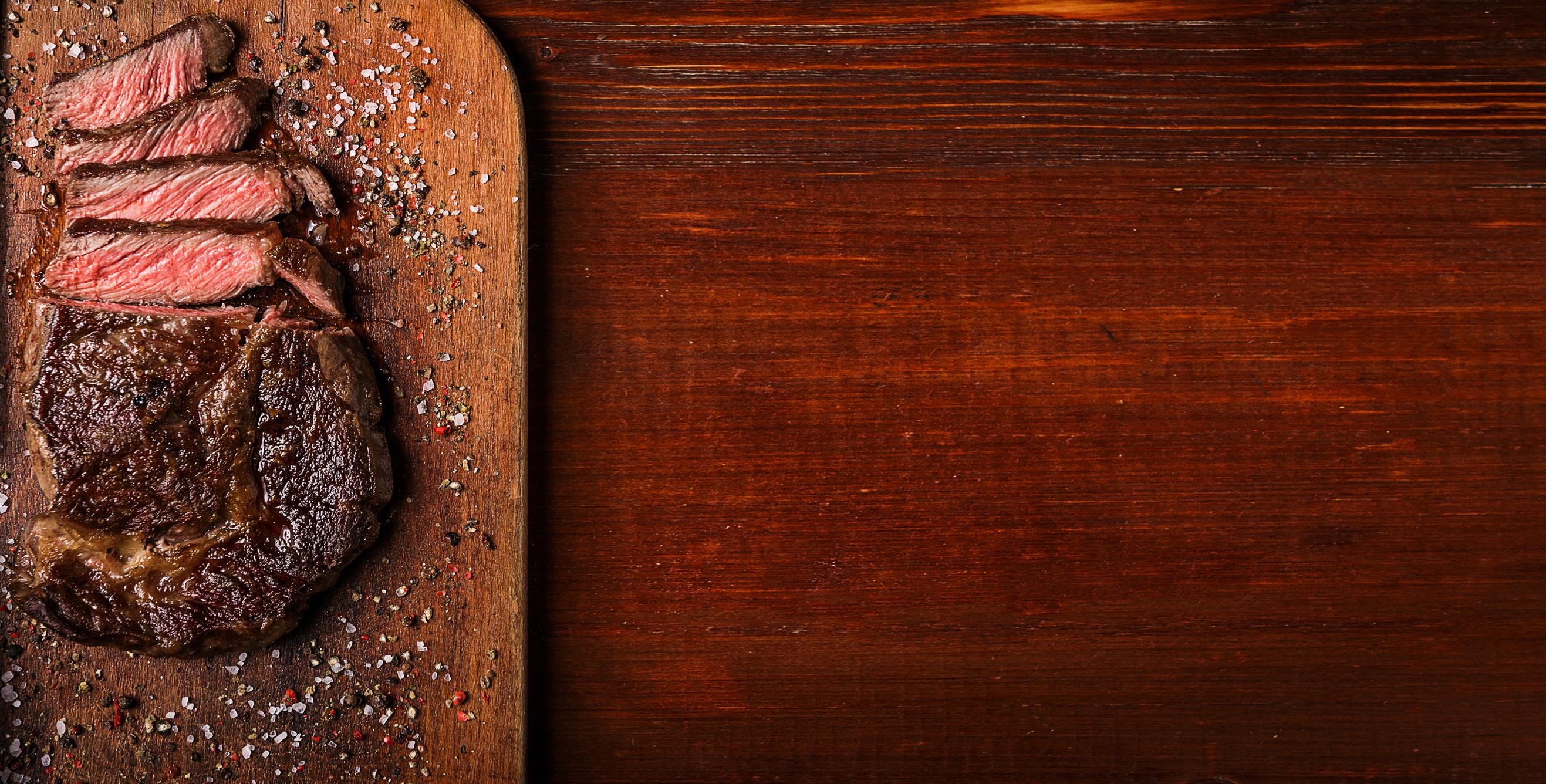
DID YOU KNOW? Every day, cattle convert things humans can’t eat like grass, forages, and byproducts from other industries into high-quality nutritious beef that fuels our bodies.
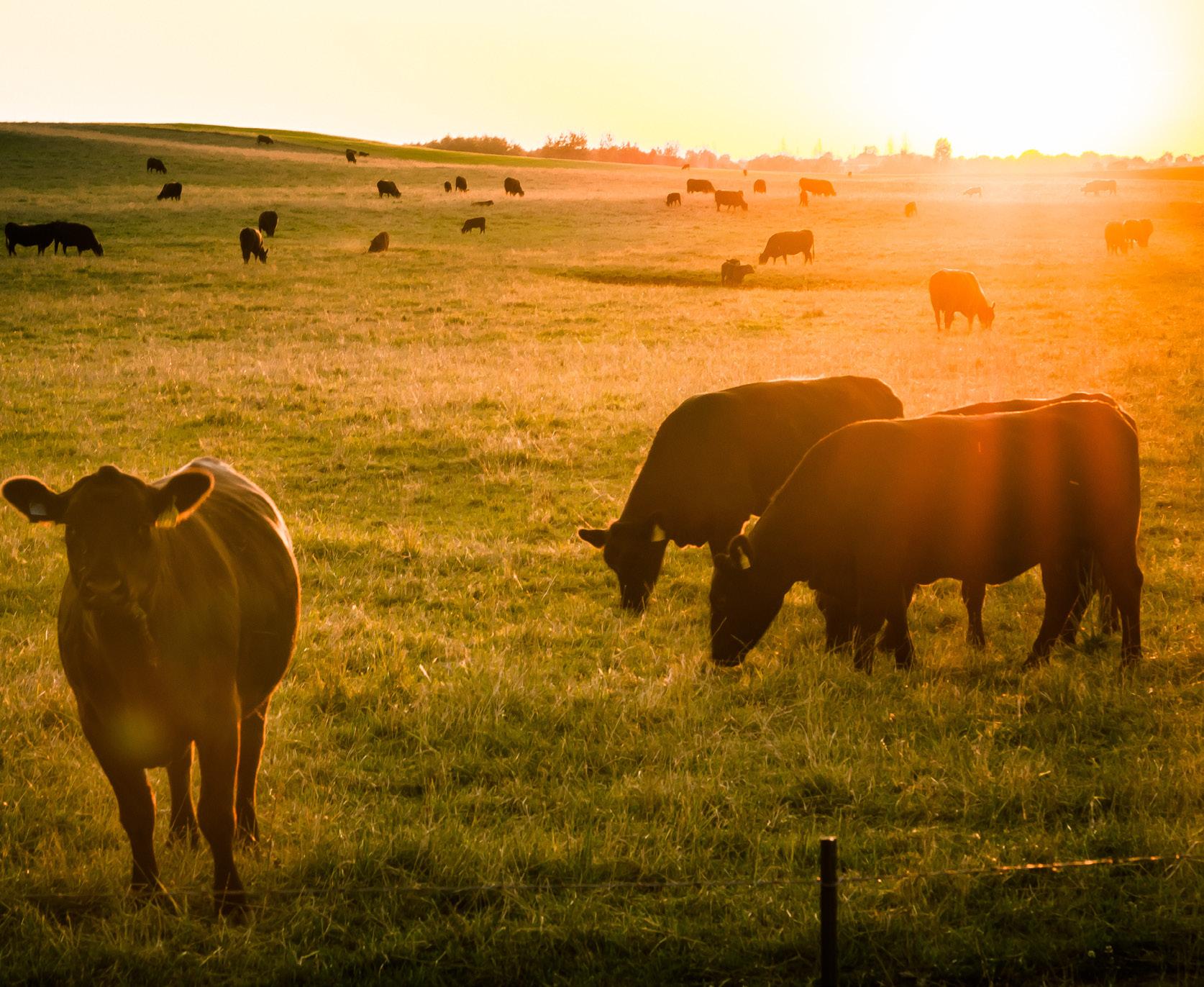
For ages, cattle have converted natural resources like solar energy and grass into high-quality protein and other products. The upcycling ability of cattle enables beef farmers and ranchers to minimize environmental impact while striving for industry-wide sustainability goals and climate neutrality.1-2
Cattle can feed on byproducts from biofuel and food production industries, such as corn stalks, distiller grains, or sugar beet pulp, reducing the volume of waste going into landfills.
439-450.
More than 44% of an animal’s live weight transforms into other goods such as leather, pharmaceuticals, cosmetics, and pet food.
3. Smith, P. 2012. Soils and climate change. Current Opinion in Environmental Sustainability 4: 539-544.
Properly managed cattle grazing can improve soil health, water quality and wildlife habitats. As the global population continues to grow, ruminant animals like beef cattle can help us make more protein with less.3-5
SUMMITING
Kelly Cunningham thrives on surprising parallels between farming and summiting mountains.
Iowa farmers are using innovative, practical solutions to protect the environment.
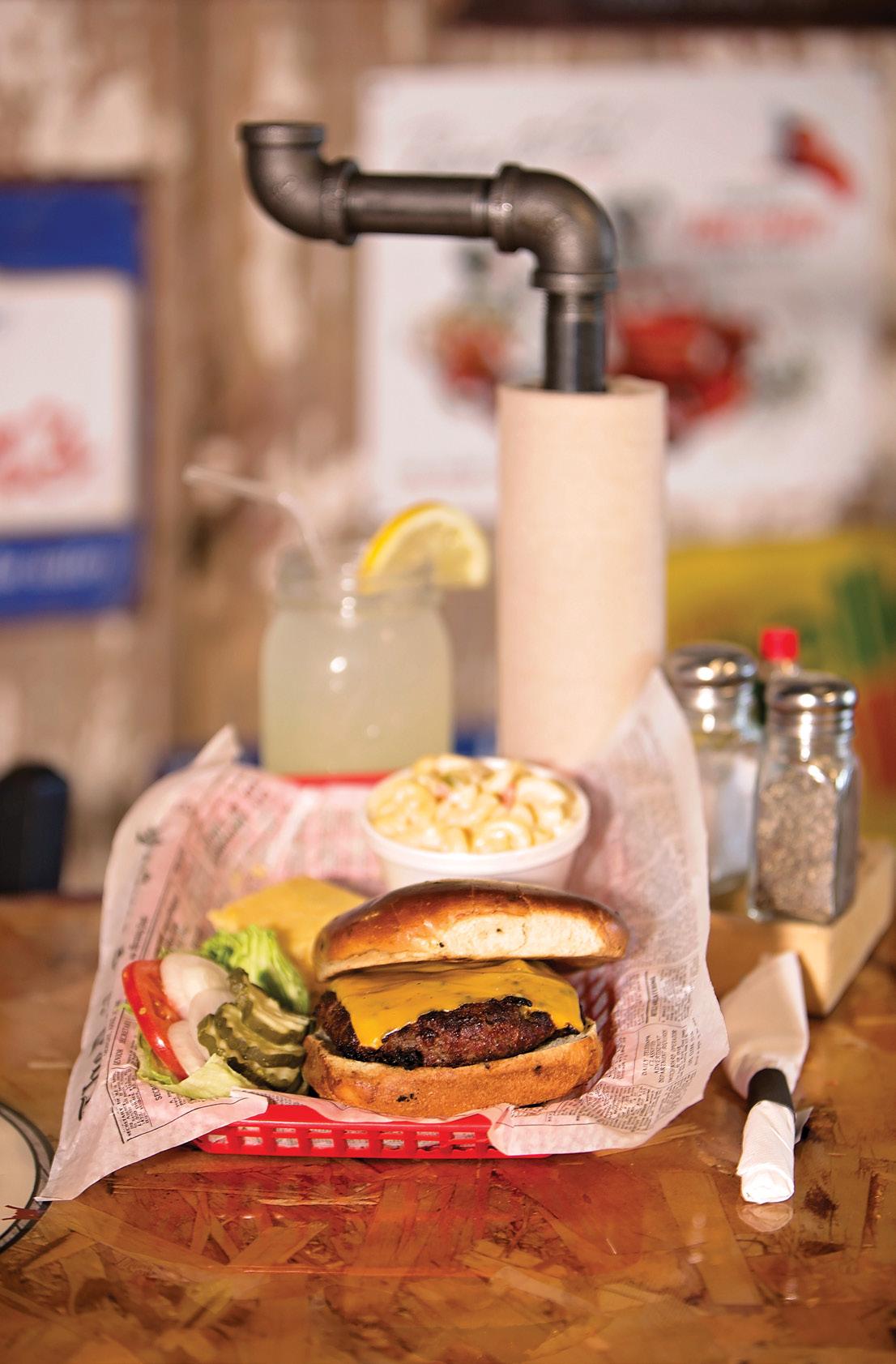

HANDCRAFTED IN THE HEARTLAND

Randy and AJ Schnebbe’s “shop local” style features metal art and culinary creations.
ON THE COVER: Photo courtesy of Lauren Grant-Vose, Zestful Kitchen. Find the recipe on Page 29.
WINTER 2022 | ISSUE NO. 12

From planting sprawling fields to selling fresh produce at farmers markets, Iowa farmers have one goal in mind: to provide nutritious and safe food. Farmers make a living from the land and their livestock, which is exactly why they provide the best possible care for both. Farmers breathe the same air, drink the same water, and eat the same meat, eggs, dairy and grains as you.
Iowa farm families hold valuable insights and perspectives that can help you make informed decisions about your food choices.
FOLLOW ALONG WITH US TO LEARN MORE ABOUT THE WORK IOWA FARMERS DO TO FEED THEIR FAMILIES, NEIGHBORS AND PEOPLE AROUND THE WORLD.

BROUGHT TO YOU BY THE IOWA FOOD & FAMILY PROJECT
PHOTOGRAPHER
JOCLYN BUSHMAN
DESIGNER
ASHTON BOLES
WRITER
BETHANY BARATTA
ANN THELEN
Thelen Public Relations
CRISTEN CLARK
Food & Swine
HALEY BANWART
Farm Roots & Chore Boots
DARCY DOUGHERTY MAULSBY
Darcy Maulsby & Co.
SARA PRESTON
CommonGround Iowa
FOUNDERS
Iowa Soybean Association
Iowa Pork Producers Association
Iowa Beef Industry Council
Midwest Dairy
Iowa Corn Growers Association
Iowa Poultry Association
Iowa Egg Council
Iowa Turkey Federation
The Soyfoods Council
Anderson Erickson Dairy
Cargill
Cookies Food Products
Corteva Agriscience
Earl May
Nursery & Garden Center
Farm Credit Services of America
Heart of America Group
Hy-Vee
Iowa Grocery Industry Association
Iowa Machine Shed Restaurant
Iowa State Fair
Key Cooperative
Latham Hi-Tech Seeds
Live Healthy Iowa
Subway
REQUEST YOUR MAILED SUBSCRIPTION AT IOWAFOODANDFAMILY.COM/MAGAZINE/SUBSCRIBE
Thank you to the Iowa Soybean Association, Iowa Pork Producers Association, Iowa Beef Industry Council, Midwest Dairy, Iowa Corn Growers Association, Iowa Egg Council, Iowa Turkey Federation, Farm Credit Services of America, Cargill, Corteva Agriscience, Key Cooperative, Latham Hi-Tech Seeds, Live Healthy Iowa and Earl May for the financial investment that makes this publication possible.
Fresh Pickings is published four times a year by: Iowa Soybean Association, 1255 SW Prairie Trail Parkway, Ankeny, Iowa 50023
For advertising information, complete the form at iowafoodandfamily.com/magazine/feedback.
Advertising space reservations must be made through the above form. In consideration of the acceptance of the advertisement, the agency and advertiser must, in respect of the contents of the advertisement, indemnify and save the publisher harmless against any expense arising from claims or actions against the publisher because of the publication of the content of the advertisement.
Comments: iowafoodandfamily.com/magazine/feedback
Submit your own letter at iowafoodandfamily.com/ magazine/letters.


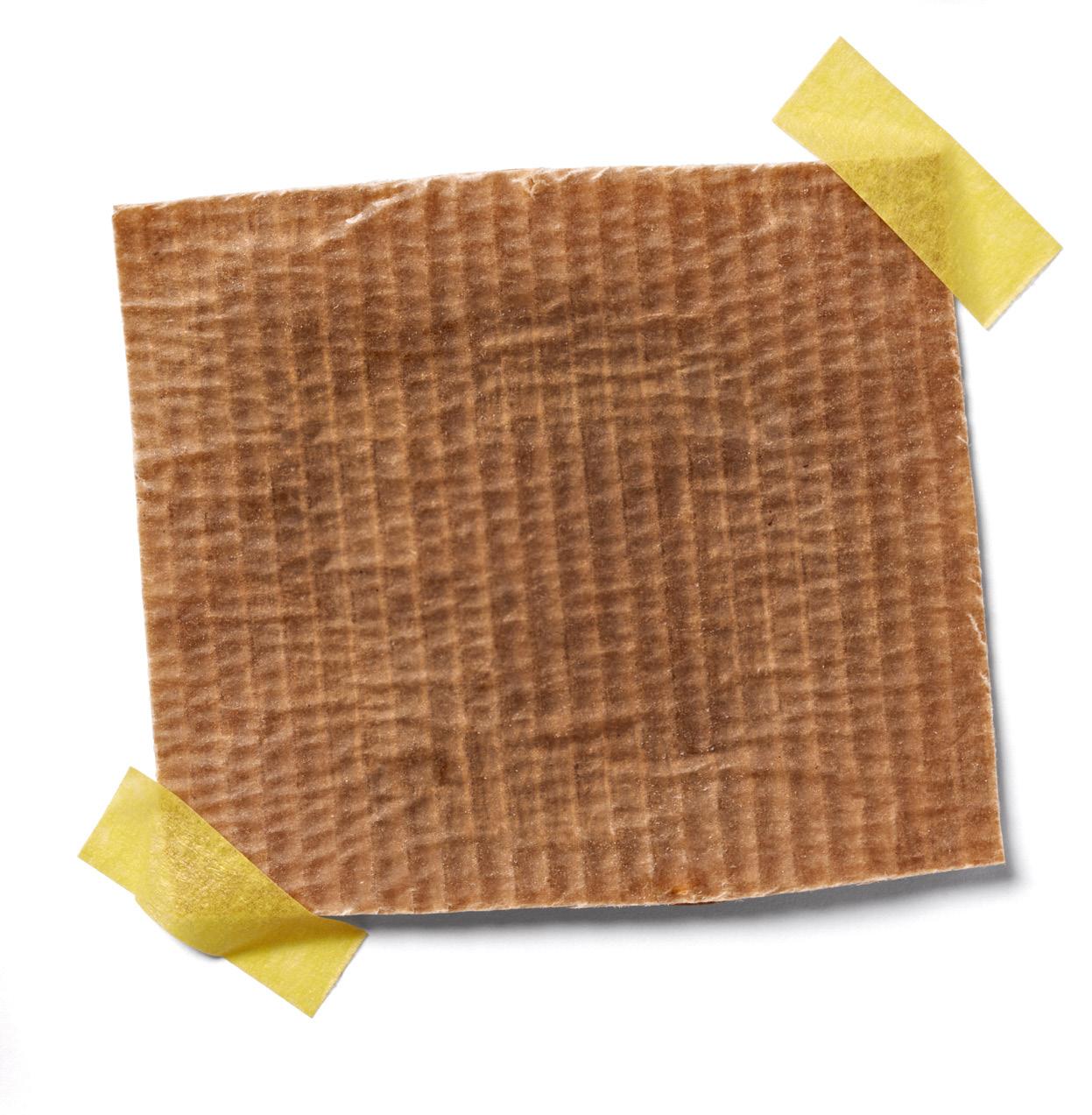


In the fall 2021 issue of Fresh Pickings , you had an article about Dubuque. I visited the lovely town for a few short hours and once the pandemic is over would like to go back and visit. Your article about the local parks and food offerings have especially tickled my interest.
— L. Ladd, AmesI first became aware of the Iowa Food & Family Project from your booth at the Iowa State Fair several years ago. My friend Jenni and I come to the fair every single year. My dad passed away in April at the age of 84, and he grew up on a farm in northeast Iowa. I did not grow up on a farm but spent two weeks every summer with my cousins on farms in the rural Elkader area, which provided my limited knowledge about farming and the dairy and pork industries. I love the stories in your magazine, and I have learned a LOT over these past few years.
Thanks for all you do to promote these wonderful farmers and all people involved in the food industry in Iowa. I could not do what they do in a MILLION years but have a HUGE respect for all who do.
— Julie Novak, Cedar RapidsI loved reading about the Fishback & Stephenson Cider House. My husband and I are planning to find a VRBO or Airbnb near there to take a weekend visit just so we can check out this fun Iowa treasure. Thanks for featuring it!
— Holly Houg, UrbandaleHi-Tech Seeds, Jethro’s BBQ and numerous farms that grow and raise livestock and crops. As I listened to food and farming experts share their passion and knowledge, I saw on the participants’ faces how impressed and eager they were to soak up the information. I was just as interested as the participants were, and left the day feeling fulfilled and proud to be an Iowan where agriculture is celebrated every day in so many ways.
I’ve always enjoyed learning. Whether it’s in an academic, a professional or casual setting, broadening my knowledge brings me joy. There’s something about learning that also helps to create connections. Once you know more about a person or situation, it’s easier to put yourself in their shoes or relate to the situation in a more personal way.
Joining in conversations with others is a tangible example of how sharing knowledge and experiences creates meaningful connections. At the Iowa Food & Family Project (Iowa FFP), we focus on finding ways to create opportunities for consumers to ask questions and be curious when it comes to food, farming and agriculture.
At a recent Food U tour we hosted for members of our highly engaged Champions group, I experienced firsthand how learning and conversations can impact perceptions and behaviors. In the past, Food U has offered the Champions group the opportunity to tour places such as Center Grove Orchard, Latham
When we asked the Food U participants what piece of information should be shared with Iowa FFP’s audience, one participant responded, “I encourage everyone to look for opportunities to learn about and appreciate the connections each of us has to our local agriculture community.” This statement perfectly summarizes Iowa FFP’s goal in providing content and experiences, which increase confidence in the food you purchase and the farmers who provide it.
As we begin this new year, many are thinking about resolutions or goals. Iowa FFP would like to invite you to join our conversation! Let’s talk about how food is grown and raised, meet the farmers who are working day in and day out to make it happen, and celebrate all that Iowa has to offer.

We want to connect with you and learn what topics or questions you want us to dive deeper into through the pages of this magazine or our activities. Engage with us on social media, write a letter to the editor or find us at local events. Above all, we hope you resolve to be curious in this new year and never stop learning!
Enjoy the isue,

Cristen Clark is a pig farmer, creator of the Food & Swine blog and an award-winning baker and cook. She lives on a farm near Runnells with her husband Mike and children Halle and Barrett.

There’s delight to be discovered in a thoughtful brunch spread. A variety of diverse dishes please palates with savory and sweet selections.
Several years ago, I visited New York City for the first time. I had won a national cooking competition and earned a trip to the New York City Wine & Food Festival. The hustle and bustle of the city made me somewhat anxious, but I found a restaurant called Sarabeth’s Bakery, where I felt right at home.
During my visit to Sarabeth’s Bakery for a late breakfast, I ordered their famous Lemon Ricotta Pancakes. These pancakes were bright in flavor from the acidity of the lemon juice, which beautifully cut through the richness of the ricotta. The dish elevated a simple breakfast staple into a celebrationworthy centerpiece. Since that time, I’ve worked to replicate the famous pancakes at home!
Brunch is a wonderful way to bring family and friends together. To plan your next brunch, try these tips.
Eggs are a staple in any brunch spread; serve an egg dish that is easily made ahead like quiche or frittata. If your kids love scrambled eggs like mine do, try the “Herbed Buttery Eggs” recipe on the next page. For perfect eggs, make them right as brunch is being served.
Pancakes can be made when brunch
preparations begin and stored on a sheet pan, covered with foil in a warm oven for up to an hour or so. To keep the pancakes moist and soft, brush with melted butter before putting them in the oven. French toast can be treated the same way. Serve with warm maple syrup and other pancake toppings, such as chocolate chips, berries or compotes.
Looking for a recipe you can start the night before? Select a slow-rising overnight cinnamon roll recipe. These recipes can be prepared to the second rise stage and placed in a refrigerator overnight. When you wake up, simply preheat the oven and bake the rolls. As a bonus, your kitchen will smell amazing!
A wonderful brunch idea comes from a friend in Texas who hosted a “Best Breakfast Sandwich” brunch party. She serves bakery buns, miniature croissants, bagels and biscuits along with eggs and breakfast meats like sausage, bacon, ham and smoked turkey. She adorns the buffet space with an assortment of jams, flavored cream cheeses, honey and various sliced and sautéed vegetables. Her guests enjoy building sandwiches according to their tastes and their creations are endlessly creative.
For a lunchtime brunch, serve deviled eggs, shrimp cocktail, salad or tea sandwiches that can be assembled the day before and set out just in time for the party.

Makes 12 pancakes
• Zest of 2 lemons
• 3/4 cup granulated sugar
• 1/2 teaspoon kosher salt
• 1 teaspoon baking powder
• 2 cups all-purpose flour
• 4 eggs, separated
• 1 cup ricotta cheese (full-fat or low-fat)
• 1 cup whole milk
• 1/2 cup fresh lemon juice (2 lemons)
Garnishes
• Powdered sugar
• Berries and lemon slices
• Pure maple syrup
In a large mixing bowl, rub zest of lemon with granulated sugar to release oils of the zest into the sugar.
Add salt, baking powder and flour to the large mixing bowl. In separate bowl, whip the egg whites until stiff peaks form. Set aside.
In a large, 4-cup glass measure or bowl, whisk together egg yolks, ricotta cheese, whole milk and lemon juice.
Add wet ingredients to large mixing bowl of dry ingredients. Mix gently. Fold in whipped egg whites.
Heat nonstick griddle or pan sprayed with cooking spray to medium or medium low heat. Drop batter by a 1/4-cup cookie dough scoop to make pancakes. Swirl scoop of thick pancake batter gently in a circle motion for even cooking as batter can be thick. Flip when edges are dry and underside is golden. This pancake won’t bubble on top like store mixes. Dust with powdered sugar before serving on warm plates with butter and warm maple syrup.
Serves 4-6
• 1/3 cup butter
• 8 large eggs
• 1/4 cup plus 1 tablespoon cold heavy cream, divided
• 2 tablespoons fresh herbs such as chives, dill or parsley
• 2 green onions, green tops only, chopped
• 1/2 teaspoon salt
• 1/4 teaspoon black pepper
Place a large skillet over mediumlow heat. Add butter to melt. In a medium mixing bowl, add eggs and 1/4 cup of heavy cream, whisk until well mixed. Add to skillet. Cook while folding until curds form and no liquid egg is running from the curds. Add herbs, salt, pepper and remaining heavy cream. Turn out onto warmed serving platter, garnishing with additional herbs if desired.

When the calendar ushers in a new year, it often serves as a time to resolve to adopt new habits or focus on achieving personal and professional goals. Through its annual 10 Week Wellness Challenge, which begins in January, the team at Live Healthy Iowa (LHI) embraces the opportunity to help influence the well-being of Iowans. This year, LHI is focused on a successful approach commonly referred to as the Six Dimensions of Wellness developed by Dr. Bill Hettler of the National Wellness Institute.
Each dimension offers perspectives for impacting a healthy lifestyle through six main areas.
Occupational . The occupational dimension recognizes personal satisfaction and enrichment in life through work. It means contributing your gifts, skills and talents to work that is personally meaningful and rewarding. It’s better to choose a career consistent with your values, interests and beliefs than to select an unrewarding one.
Physical. By learning about diet and nutrition, optimal physical wellness is met by combining good exercise and eating habits. Following this approach fosters an appreciation for the relationship between sound
nutrition and how your body performs. Looking good and feeling terrific often lead to enhanced self-esteem, determination and a sense of direction.
Social. The social dimension encourages contributing to your environment and community. Actively seeking ways to preserve the beauty and balance of nature along with enhancing personal relationships and important friendships is essential.
Intellectual. Overall wellness involves stretching and challenging your mind with intellectual and creative
pursuits. Identifying potential problems and choosing appropriate courses of action based on available information is encouraged rather than waiting, worrying and contending with significant concerns later.
Spiritual. It is better to live each day in a way that is consistent with your values and beliefs than to do otherwise and feel untrue to yourself.
Emotional.
Emotional wellness follows two core philosophies – it is better to be aware of and accept your feelings than to deny them, and it’s better to be optimistic than pessimistic.


 By Haley Banwart
By Haley Banwart
Whether you prefer surfing the snow on a sled, snowboard or set of skis, wintertime activities offer a fun and thrilling escape from the confines of home.


From the heart-pounding anticipation of balancing atop a hill to the adrenaline-filled excitement of careening down a powdery snow path, there’s a restorative magic to these forms of outdoor recreation.
And in Iowa, you don’t have to go far to find it.
Conveniently located along the Des Moines River Valley just 5 miles west of Boone, the northfacing slopes at Seven Oaks Recreation suddenly rise above the flat central Iowa terrain dotted by surrounding acres of corn and soybean fields.
The facility has been family-owned and operated since 1997 and offers year-round outdoor recreation, including skiing, snowboarding and snow tubing during the winter season.

In addition to outfitting 650 ski rentals, 250 snowboard rentals and 120 snow tubes to visitors of all ages, Seven Oaks features 11 impressive vertical runs as well as a terrain park, rail yard and a beginner area designed to accommodate skiers and snowboarders of all skill levels, plus a four-chute snow tube park.
“We may not have mountains in Iowa, but aside from the pitch and length of the runs, you’ll enjoy the same experience at Seven Oaks as any other ski area
from the gear to the groomers,” says Seven Oaks Co-owner and General Manager Joel Bryan.
“Mother Nature plays a key role in our business, and while winter is sometimes viewed negatively, we feel very fortunate to be able to provide a family-friendly atmosphere. It’s a place where you can hear laughter and music playing, watch as fellow skiers try new tricks or warm up with a cup of hot chocolate at the lodge.”
During the 2020-2021 season, Seven Oaks welcomed a record number of visitors when the COVID-19
pandemic turned life upside down and drove many families to find safe ways to spend time together outdoors.
According to Bryan, business hasn’t slowed down since, but that shouldn’t stop first-timers from joining in on the fun.
“Before you arrive, be sure to check out the first-time visitor guide on our website,” Bryan advises. “We offer free mini-lessons and paid private lessons for beginners and encourage you to come in with an open mind.”
“Dozens of other skiers and snowboarders will be learning
alongside you, so come into the experience with realistic expectations and be ready to have a blast,” he adds.
For Bryan, the most rewarding aspect of his role is seeing families smiling and exhausted after spending a day on the slopes.
“Skiing is a true sport for life; it’s something you never grow out of,” he shares. “I love watching kids come here with their families, learning the sport and making lifelong memories together.”
Visit Seven Oaks at 1086 222nd Dr. Boone, IA 50036

Dress warmly with a base layer that wicks away moisture, followed by a synthetic fleece or wool layer and a waterproof outer layer.
Check



1 2 3
T ravel along Iowa’s western border, and you’ll find Mt. Crescent Ski Area etched among the bluffs. With a peak elevation of 5,118 feet, Mt. Crescent skiers and snowboarders can enjoy a little over 15 miles of marked trails and a variety of slopes fit for newcomers, intermediates and experienced shredders. If sledding is more your style, make a reservation to slip and slide down Mt. Crescent’s scenic sledding hill, which spans the length of three football fields.
Lo cated in the southeast corner of Sioux City, the crown jewel of Cone Park’s 35 acres of dedicated recreation space is the state-of-the-art 700-foot hill that features multiple lanes of snow tubing excitement. Admission to the park includes a 3-hour session with unlimited rides, access to single or tandem snow tubes and a 450-foot carpet lift that will whisk you to the top. Stay after dark on select weekends and enjoy an evening of snow glow tubing complete with music and a colorful LED light show.
Overlooking 100 square miles of eastern Iowa countryside, Sundown Mountain is another skiing hot spot where visitors can spend a fun-filled day flying down the slopes with friends and family. Home to 21 runs carved out among picturesque cedar trees, the resort also features a variety of terrain parks and several lodges and warming stations. Feel the need for speed? Venture over to the free timed racecourse for some friendly competition.


As a dairy farmer, Kelly Cunningham is accustomed to rising above challenges and summiting new heights in his sustainable operation. As an adventurer with a passion for mountain climbing, the same steadfast endurance Cunningham has on the farm fuels his treks to the world’s highest peaks.

Since he began mountain climbing during a youth group exercise, Cunningham has never looked back. With a doctorate in dairy cattle nutrition from Purdue University, he saved money for years to fulfill his dream of owning a dairy. While the journeys of farming and summiting mountains may seem as different as night and day, Cunningham thrives on the parallels.
“On a dairy farm, consistency and hard work yield rewards with healthy cows and quality milk production,” he says. “On a mountain, consistency and hard work yield the summit.”
Cunningham and his wife Christy are the operating partners of Milk Unlimited in Atlantic, where 3,400 cows produce more than 800,000 gallons of milk monthly on their farm. The Cunninghams were honored in 2019 with the Wergin Good Farm Neighbor Award for their outstanding care of animals and the land.
“Our cows are inside climate-controlled free stall barns, during inclement weather our cows rest on beds created solely of sand,” Cunningham explains. “I like to say that our cows get to lay on a beach every day of the week.”
The cows – a crossbred mix of Holstein,
Montbéliarde and Swedish Red –efficiently produce milk with higher butterfat and protein content, making it ideal for cheese.
“We are part of Associated Milk Producers Inc. (AMPI), which is the largest cheese cooperative based in the U.S.,” Cunningham says. “Our milk is processed in nearby Sanborn, and our main end product is cheddar cheese.”
Cunningham was an early adopter of cover crops on his 1,000 acres of farmland. These crops are planted to cover the soil rather than to be harvested. Cover crops help manage soil erosion, soil fertility and soil quality.
“On ground that isn’t robust for
growing corn or soybeans, we plant forage mixes in both the spring and the fall,” Cunningham says. “These forages are harvested, yielding similar tonnage as corn silage, and used as economical forage source for the cows.”
In addition, the manure from the dairy cows and steers raised for beef is used to fertilize crops. This process creates a full circle of sustainability, something that’s a high priority for Cunningham.
“The cows are the ultimate recyclers, taking in things humans can’t digest, such as leftover soybean and corn byproducts (from making vegetable oil or ethanol) and turning it into nutritious milk. In turn, the milk is converted to cheese, ice cream and other delicious products,”

Cunningham explains. “It’s a wonderful cycle of sustainability.”
“Sustainability must also go beyond the day-to-day, yearto-year or generation. It takes hard work and perseverance. Sustainability is a continuous process that keeps cows healthy and improves their longevity, along with keeping our soil and our farm productive.”
While dairy farming is a demanding, around-the-clock profession, Cunningham’s mind and spirit are reinvigorated by tackling the world’s tallest and steepest elevations.

The world has Seven Summits, which are the highest mountains in each of the seven traditional continents. Cunningham has climbed three of the seven, including reaching 22,837 feet on Mount Aconcagua in Argentina. He’s climbed to the top of Mount Elbrus, the highest mountain in Europe, at 18,510 feet. In May, Cunningham stood atop the summit ridge of Denali, also called Mount McKinley, the tallest mountain in North America, located in southcentral Alaska. With a peak that reaches 20,310 feet above sea level, it’s the third highest of the Seven Summits.

To put this in perspective, Hawkeye Point, at an elevation of 1,670 feet above sea level, is the highest point in Iowa. At 14,443 feet, Mount Elbert is Colorado’s tallest summit.
The same endurance it takes to run a highly laborious dairy
farm – milking most cows at least twice a day – powers Cunningham’s strides uphill.

“Denali is about a 28-day trip. I flew to the mountain in an airplane, landed on the glacier and for the next 28 days, I was on frozen snow and ice, living in a tent, and melting snow and ice for water,” Cunningham explains. “All my food was in a backpack, and then I inched up the mountain. I did a trek up to leave some supplies, and then went back to get more supplies. Essentially as a climber, you stairstep up and down the mountains.”
Only about 300-350 people climb to the top of Denali each year. “To know that you’re one of those people really gives you a lift. The scenery of God’s creation is magnificent,” Cunningham adds.
Cunningham is quick to credit his wife and team of 30 employees for supporting his climbing passion.
“Being gone nearly a month on a mountain comes at a cost for all your people. They don’t get their days off, and they might not get to enjoy their family as much while I’m away,” he says. “When I get back, my priority is to make it fair and equitable and pay their kindness forward.”
While his hobby is about embracing the peaks of nature, in business, Cunningham focuses on reducing the typical peaks and valleys of dairy production. “Just like climbing a mountain, I focus on incremental, steady progress,” he says. “Consistency is the key. It yields sustainable rewards and allows you to summit the challenges.”

If you’ve ever bought pre-sliced, ready-to-eat, fresh fruits or vegetables at the grocery store, do you wonder what happens to all those rinds, stems and peels? A unique partnership between Hy-Vee and livestock producers is transforming those scraps into “salad” for cattle.
“The cows love it,” says Duane Steenhoek, a sixth-generation farmer from Chariton. “Feeding these produce scraps helps keep the cattle in good condition, and it keeps thousands of pounds of material out of the landfill.”

This is one of many innovative, eco-friendly solutions taking root across Iowa, as crop and
By Darcy Dougherty Maulsbylivestock farmers transform waste products into feed, fuel and fertilizer.
Steenhoek’s partnership with Hy-Vee developed about five years ago when the grocery chain moved one of its food processing facilities from central Iowa to Chariton. “Hy-Vee was looking for a place other than the landfill to take their sweet corn husks, cantaloupe rinds, strawberry hulls and other produce scraps,” says Steenhoek, whose family raises cattle, hogs, corn and soybeans.
Steenhoek teamed up with fellow cattle producer Nick Hunter to take the scraps.
“Cattle can upcycle a variety of feed sources, so this works well,” Steenhoek says.
Steenhoek built a receiving area to hold the scraps, which are delivered every other day via a stainless steel, end-dump trailer. He uses a skid loader to add the scraps to his feed mixer wagon, along with ground cornstalks, hay or silage, and distillers grains. (A co-product of ethanol production, distillers grains offer a nutritious, cost-effective feed ingredient.) The total mixed ration contains nutrients cattle need to grow and stay healthy, plus it helps Steenhoek lower his feed bill.
“This has allowed me to add a new herd of cows,” adds Steenhoek, who is feeding an additional 150 cows.
Steenhoek feeds approximately 12,000 pounds of produce scraps a day. Hunter also feeds a similar amount to his cattle. “That’s more than 20,000 pounds of produce scraps a day that aren’t going into the landfill,” Steenhoek says. “There’s no reason for a product like this ever to go to waste. Plus, our cattle turn those scraps into thousands of pounds of highquality Iowa beef.”
Iowa turkey producers are also finding new ways to support a healthier planet while producing healthy food. West Liberty Foods (WLF), the largest supplier


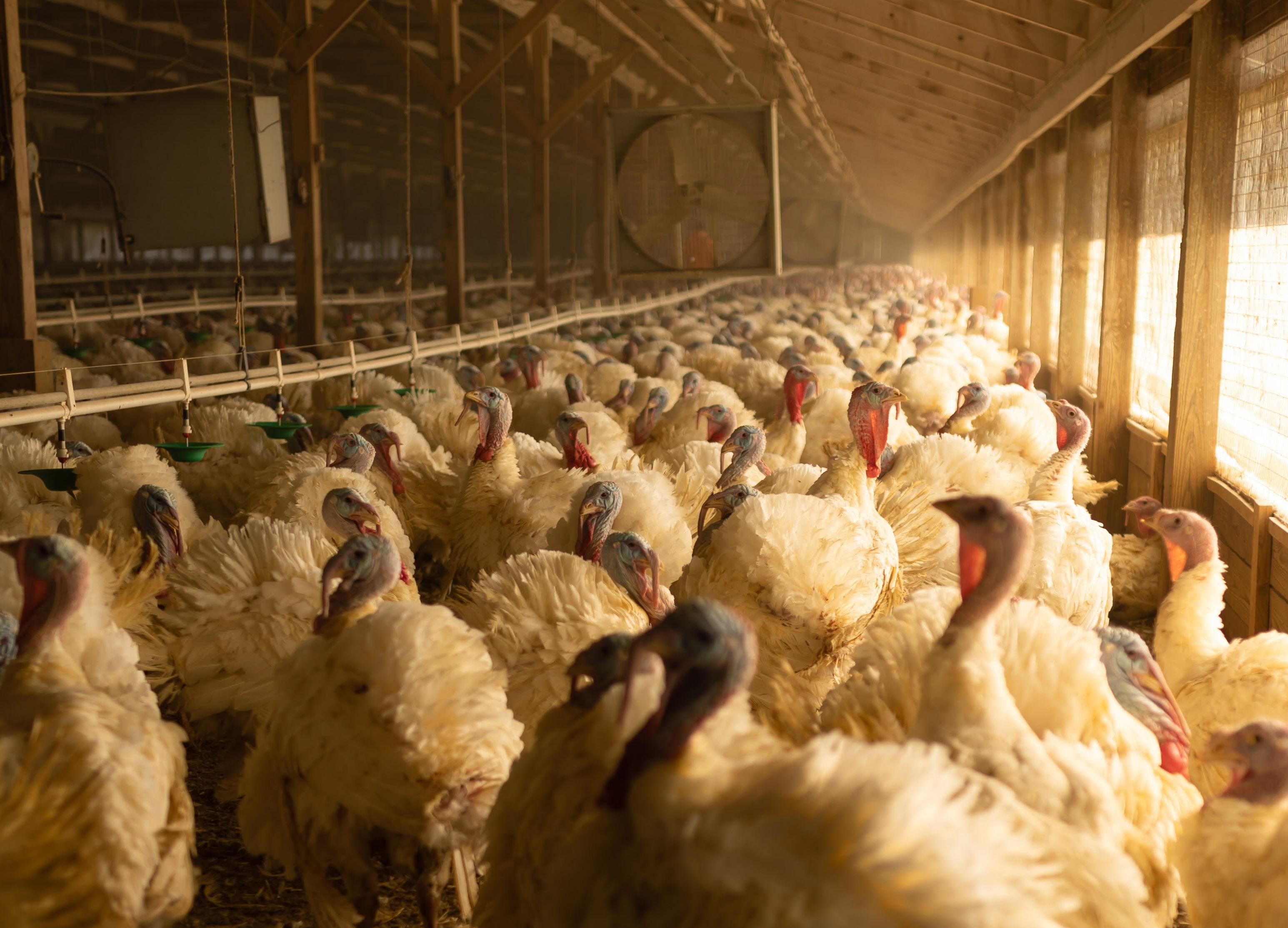
of meat products to Subway restaurants, marked a major milestone nearly a decade ago with “landfill-free” verification.
“Our CEO visited Coca-Cola a number of years ago and saw their landfill-free strategies,” says Paul Hill, who has served as WLF’s chairman since 1996.
“We started looking into this idea for WLF, especially if it could be revenue neutral.”
By December 2012, WLF became verified “landfill-free,” meaning that less than 1% of the company’s waste ends up in a landfill. “Each year, we find ways to recycle and re-use millions of pounds of waste,” says Hill, a third-generation turkey producer from Ellsworth who operates Circle Hill Farms with his family. “We’re the only meat company in America that’s third-party audited, landfill-free.”
Turkeys are housed in special engineered barns to ensure high standards of biosecurity.By 2016, all of WLF’s facilities became landfill-free, including its operations in West Liberty and Mt. Pleasant, Iowa; Tremonton, Utah; and Bolingbrook, Illinois. WLF has annually eliminated nearly 120 million pounds of waste that were previously sent to local landfills. The company supports recycling programs and partnerships with various waste vendors. “The key is getting paid for various waste streams,” Hill says.
Hill is well-versed in this topic. He implemented a similar system on his family’s turkey farm when he began selling fermented, composted turkey manure about 30 years ago. While he started researching these opportunities in the 1970s, the Farm Crisis accelerated his efforts. “We needed to bring in

more revenue, so I asked, ‘How do we make something out of nothing?’”
Hill had plenty of turkey manure, which naturally has a good carbon-nitrogen ratio. He finetuned a system to compost the manure and make it even more useful. When the manure pile reaches a specific temperature for a certain length of time, it kills harmful pathogens, destroys weed seeds and creates a safe, effective fertilizer.
This product, which the Hills market through Circle Hill Organics, has become especially popular with organic corn and soybean farmers within a 150mile radius of the family’s farm. “We sell nearly 20,000 tons of this product a year,” Hill says. “We’ve sold out of this fertilizer every year since 1998.”
“Each year, we find ways to recycle and re-use millions of pounds of waste. We’re the only meat company in America that’s thirdparty audited, landfill-free.”Paul Hill, a farmer near Ellsworth, takes great pride in being a turkey producer. — Paul Hill, speaking about West Liberty Foods’ commitment to sustainability
Practical innovation continues to drive the Hill family’s farm and WLF. The West Liberty company is evaluating options for carbon sequestration, a process where carbon dioxide is removed from the atmosphere and held in solid or liquid form. “Sustainability is a balancing act, and there’s a learning curve with all this,” Hill says.

Bill Couser knows what Hill means. The Nevada-area farmer and ethanol proponent supports Summit Carbon Solutions, an underground pipeline designed to keep excess carbon dioxide (CO2) out of the atmosphere.
“If you’re concerned about climate change, this is a carbon solution,” says Couser, referring to this new business platform from Summit Agricultural Group in Alden, Iowa. The proposed pipeline would pump liquefied CO2 collected from Midwestern ethanol plants and store it underground in North Dakota. Project leaders say this would take 10 million tons of CO2 out of the atmosphere each year, which is equivalent to taking 2 million cars off the road annually.
“Each bushel of corn that is used to produce ethanol is one-third alcohol, one-third distillers grains and one-third CO2, after the fermentation process,” adds Couser, one of the founders of
Lincolnway Energy, a Nevada-area plant that produces 86 million gallons of ethanol per year. “That equates to 16 pounds of CO2 per bushel. The pipeline creates a way to prevent this CO2 from escaping into the atmosphere.”
The link between agriculture and sustainability intrigues
Couser, a fifth-generation farmer who raises corn, soybeans and operates a 5,200-head cattle feedlot with his wife Nancy and sons Casey and Tim. The Cousers, who have received the National Cattlemen’s Foundation Environmental Stewardship Award, have partnered with environmental agencies and universities on many research studies and pilot projects.
Bill stands next to a barn on the property where his great-grandfather and father also farmed.“I love to share accurate information about farming and bring rural and urban communities together.”
They’ve focused on their Modern Ag Experience Farm in the last several years, which they created from a former landfill. “This is a diamond in the rough,” says Couser, who hauled 57 truckloads of junk and 17 old cars out of the farm’s ravine.
The Cousers have tiled some of this land in 40-acre quadrants. They also use bioreactors and saturated buffers to help remove nitrates from ag drainage water. They’re working with Iowa State University researchers to study water quality and soil health.
The Modern Ag Experience Farm, which includes untilled


acres filled with wildflowers and other native plants, is open to the public for tours. (Visit modernagfarm.com for details.) “I love to share accurate information about farming and bring rural and urban communities together,” says Couser, whose guests have ranged from foreign dignitaries to U.S. Secretary of Agriculture Tom Vilsack.
No matter who he’s speaking with, Couser shares his practical approach to sustainability. “Farming practices need to be environmentally friendly and profitable. Most of the time, when you can find a solution for the first factor, the second one takes care of itself.”
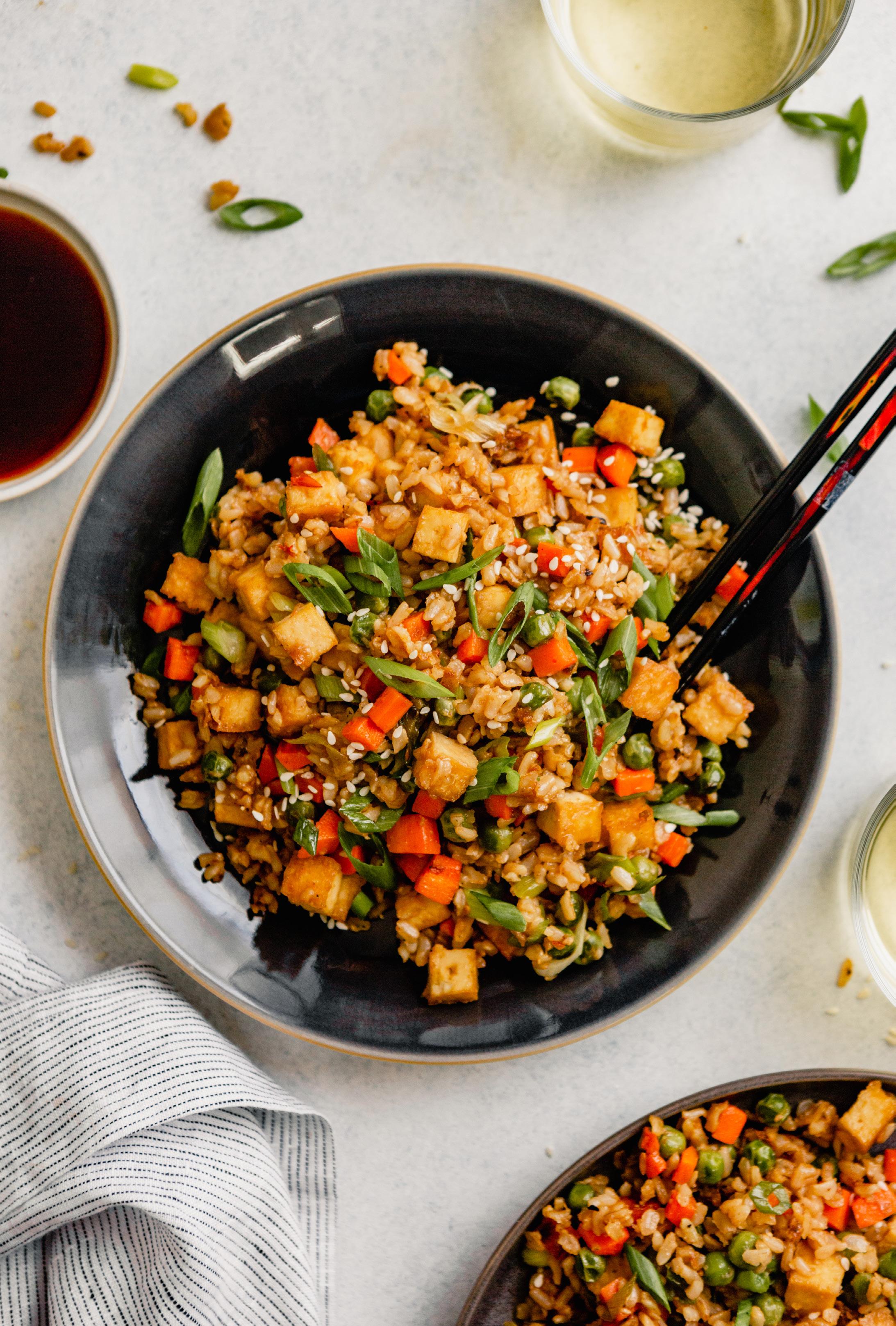 Recipe on Page 29.
Recipe and photo courtesy of Lauren Grant-Vose.
Recipe on Page 29.
Recipe and photo courtesy of Lauren Grant-Vose.
here’s science and art to creating delicious food. Whether it’s a farmer raising healthy livestock, a chef turning foods into plated art or a home cook experimenting with flavorful new recipes. A common element is often a passion for the way meals bring people together by pairing wholesome proteins with the flair of seasonal, imaginative and sustainable ingredients.
Lauren Grant-Vose, a food scientist, and Aaron Holt, a self-taught chef and farmer, are two central Iowans who believe there is a space and a place on every plate for a variety of foods. Inspired by fresh ingredients, including seasonal vegetables, microgreens and edible flowers, and the flavors, textures and nutrition of animal- and plant-based proteins, Grant-Vose’s and Holt’s culinary concepts encourage thinking beyond a one-size-fits-all approach.

 By Ann Thelen
Eating healthy doesn't necessarily mean cutting out food groups.
By Ann Thelen
Eating healthy doesn't necessarily mean cutting out food groups.
While diet fads are coming and going, eating healthy doesn’t necessarily mean cutting out food groups or choosing one type of protein source over another.
“In the food industry, many people profit from restrictive diets,” explains Grant-Vose, who as an entrepreneur has worked for countless food magazines and test kitchens, including Better Homes and Gardens and Cuisine at Home. “I believe in creating meals around a spectrum of foods. Just because someone likes vegetarian meals from time to time doesn’t mean they don’t also love a delicious steak.”
Through her nationally known blog, Zestful Kitchen, Grant-Vose delights followers with recipes


packed with vibrancy, textures and ingredients that bring out the best in food.
“I create recipes around getting back to the basics with wholesome ingredients that are as good for us as they taste,” she explains. “My recipes use a lot of vegetables, meats, fish and healthy fats, letting nature add the sweetness.”
It’s common for cooks and chefs to pair many animal-based proteins together, such as eggs and pork in omelets or quiches, beef and dairy in beef stroganoff or cheeseburgers, and pork and turkey for a sandwich or casserole. Pairing plant- and animal-based proteins might feel less common, yet it’s an easy way to boost variety and nutrition in meals.
 Lauren Grant-Vose creates recipes using wholesome ingredients.
Vibrant flavors and textures bring out the best in food.
Lauren Grant-Vose creates recipes using wholesome ingredients.
Vibrant flavors and textures bring out the best in food.
A common food in GrantVose's kitchen is tofu, which she loves using alongside shredded chicken or pork and broccoli in a stir-fry.
Tofu, made from soybeans, is a good source of a complete protein – meaning that it has a well-balanced amino acid profile – in addition to fiber, potassium, magnesium, iron, copper and manganese. Combined with meats, dairy or eggs, which also boast beneficial vitamins, minerals and protein, it elevates the nutritional profile of recipes.
“When cooking with tofu, it’s not so much about adding flavor to a dish, but rather adding more nutrition and texture. Tofu soaks up many flavors from the other ingredients and holds onto the sauce, especially when it’s crumbled instead of cubed. It works beautifully when
paired with other proteins,” Grant-Vose says.
“Tofu also helps meat go further. Crumbling tofu in with ground beef can economically turn a meal for four into a meal for six,” Grant-Vose says. Or it’s a perfect texture to add to egg salad.
She recommends thinking about each food’s flavor profile when pairing proteins. Chicken and edamame might not be the most natural pairing because they are both pretty mild. So add herbs, spices and vegetables for more texture and flavor. Beef and pork can be excellent with soyfoods.
“The beef or pork can drive the main savory flavor, and then tofu or edamame can be a supporting player. Or, if you want tofu to be the main player in a burger, try adding bacon on top,” she says.
• 14-ounce package extra-firm tofu
• 2 tablespoons plus 1 teaspoon grapeseed oil, divided
• 1 ¼ cup diced carrots
• 1 ¼ cup green peas
• 1 cup sliced green onions
• 2 teaspoons
minced garlic
• 2 teaspoons
minced ginger
• 3 cups cooked brown rice, cooled
• 3 tablespoons lowsodium soy sauce,
• 1 tablespoon
vegan mushroom sauce or oyster sauce
• 1 teaspoon chili garlic sauce
• 1 teaspoon rice vinegar or white vinegar
• 2 teaspoons
toasted sesame oil
• Sesame seeds, to serve, optional
Cook brown rice according to package instructions. Set aside.
Heat oven to 400 degrees F.
Cut tofu horizontally into 3 planks, wrap tofu in a clean absorbent kitchen towel and set something heavy on top (like a cast iron skillet), let tofu press for 15 minutes.
Dice tofu into ½-inch cubes; toss with 1 teaspoon grapeseed oil to coat; arrange in a single layer on prepared baking sheet and season with salt. Bake tofu until golden brown and firm to touch, about 30 minutes.
Meanwhile, heat a 12-inch sauté pan or castiron skillet over medium-high. Add 1 tablespoon grapeseed oil and swirl to coat; once shimmering add carrots, peas and half of the green onions; cook until carrots are tender, about 5 minutes; season lightly with salt and black pepper. Transfer vegetables to a bowl.

Add remaining tablespoon grapeseed oil to now empty sauté pan over medium heat and heat until shimmering, add garlic and ginger and cook 15 seconds until fragrant. Stir in rice, breaking up any clumps, and press into an even layer; cook, without moving, for 3 minutes. Using a wooden spoon, stir rice, scraping bottom of pan as needed, reduce heat to medium, and stir fry until rice is golden brown, 4–5 minutes.
Stir in tofu, cooked vegetables, soy sauce, oyster sauce, chili garlic sauce and vinegar and fry for 2 more minutes. Off heat, stir in sesame oil and remaining scallions; season with additional soy sauce and oyster sauce to taste.
Finish with sesame seeds and serve with extra chili garlic sauce or sriracha. Or add an over-easy egg to each serving for extra protein.
Grant-Vose pairs edamame with bacon for a savory and protein-rich dish.
Makes 5 ½ cups.
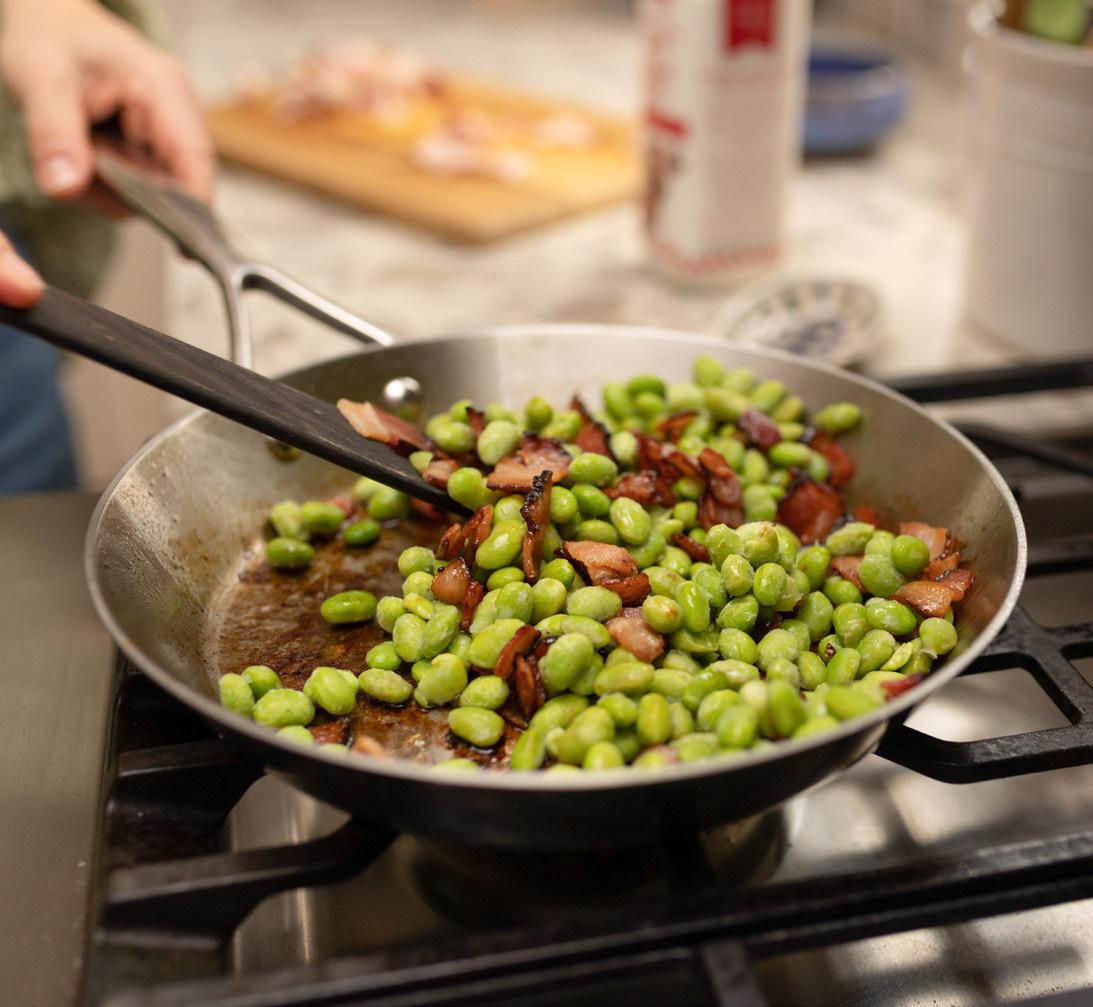
• 1 tablespoon olive oil
• 1 yellow onion, diced
• Kosher salt

• Crushed red pepper flakes
• 1 pound bulk Italian sausage, hot or mild
• 2 fennel bulbs, fronds reserved
• 4 large cloves garlic, chopped (2 tablespoons)
• 4 cups low-sodium chicken broth
• 1 small bunch Tuscan kale, stems removed, leaves torn into bite-size pieces (about 9 cups)
• 2 (14.5-ounce) cans cannellini beans, drained and rinsed
• 2 cups whole milk, warmed
• 2 tablespoons white wine vinegar
Parmesan toast
• 6 thick-cut slices wholewheat or sourdough bread
• 1 cup shredded Parmesan
Heat oil in a large pot or Dutch oven over medium. Add onion, ¼ teaspoon salt and ¼ teaspoon red pepper flakes; cook until softened and translucent, about 5 minutes.
Add sausage and cook, crushing with a wooden spoon, until cooked through and browned, 6 – 8 minutes. Drain all but 2 tablespoons drippings from pot. Meanwhile, quarter fennel bulbs lengthwise, then slice into ½ inch-thick slices (you should get 4 – 5 cups). Add fennel and garlic to pot and cook 2 minutes.
Add broth, bring to a boil, then reduce to a simmer over medium and cook until fennel is nearly tender, about 5 minutes.
Meanwhile make Parmesan Toasts. Heat broiler to high with rack set 6-inches from element. Arrange bread slices on a baking sheet and broil until lightly toasted, about 2 minutes. Flip bread and top with Parmesan, dividing cheese evenly between toasts. Broil toasts until Parmesan is melty and starting to brown, 2 – 3 minutes; set aside.
Stir kale, beans and milk into soup; cook until kale is wilted, about 2 minutes. Stir in vinegar and season with additional salt, red pepper flakes and vinegar to taste.
Serve soup with Parmesan toast and reserved fennel fronds.
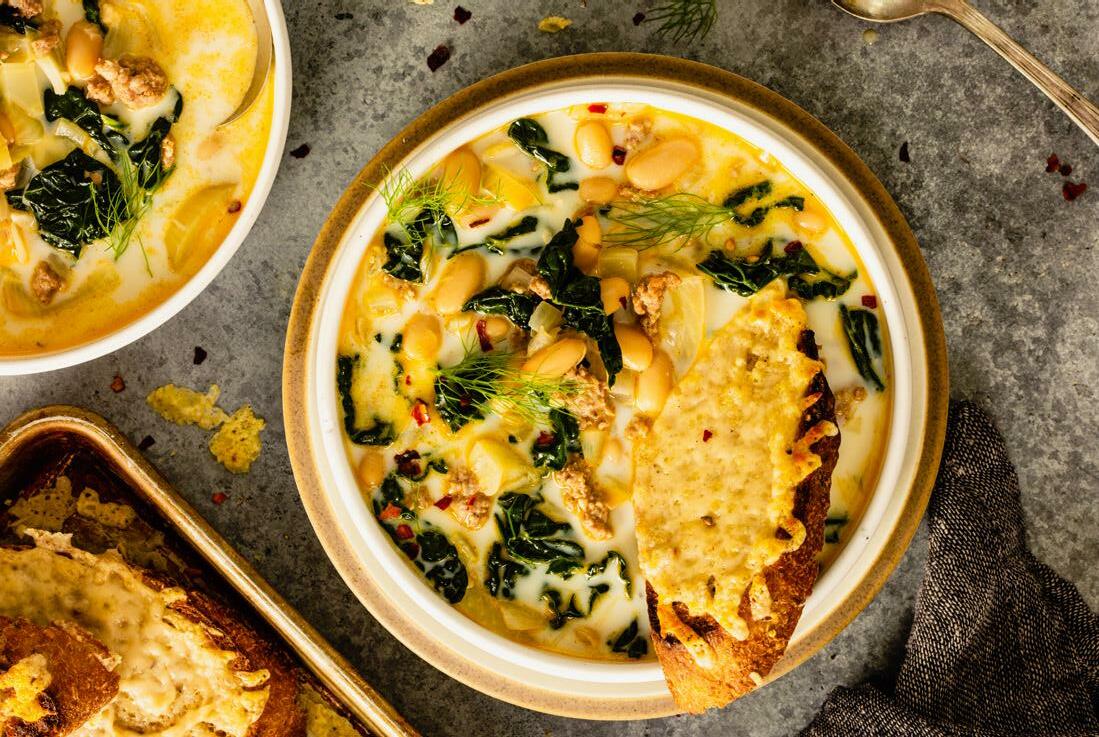
Makes 12 cups.
Aaron Holt’s passion for pairing proteins with gardenfresh ingredients stems from his childhood and cooking made-from-scratch meals with his mom. As a fourthgeneration farmer, he owns Doolittle Farms in Story City, a 53-acre farm featuring a 1905 house built by his maternal great-grandfather. Today, he and his wife Amber are raising their daughters Olivia and Josephine as the fifth generation on the family farm aptly bearing his mom’s maiden name. They grow a variety of fruits and vegetables.
“Sustainability is the most important factor for me when it comes to food,” Holt explains, whose love of food drew him into the food industry at 15 years old, working his way up from a dishwasher to restaurant general manager to award-
winning chef. Initially studying architecture at Iowa State University, he eventually left college to pursue his passion for cooking, creating memorable meals and sustainable farming.

His motto is creating the farm your great-grandparents would recognize. He does this by using time-tested practices as part of his focus on sustainability and preserving the farm for the next generation and beyond.
“The way previous generations survived was by growing and raising nearly everything they ate; canning, curing and fermenting foods; and reducing waste by using every component of the animal,” he explains.
Part of his mission of sustainability includes mixing plant-based foods with meat. For example, he enjoys creating a burger that is half beef and half sauteed and chopped mushrooms.
Aaron Holt’s finesse for agriculture and crafting thoughtful cuisine marries the best of both worlds. Recipe and photo courtesy of Lauren Grant-Vose, Zestful Kitchen.Named the Iowa Restaurant Association’s 2018 Chef of the Year, Holt’s finesse for agriculture and crafting thoughtful cuisine marries the best of both worlds. His day job is serving as a consultant for Sysco Foods, helping open restaurants and providing counsel for people to be successful in the industry.
As a creative outlet, Holt hosts farm-to-table and private in-home dinners where guests are immersed in delightful creations, such as Iowa beef short rib with a sweet potato hash, spring toast with a beet-cured deviled egg or seared duck with fall risotto.

Always in Style: Fresh and Simple

Holt is deliberate in how he pairs foods. Many feature ingredients grown seasonally on his farm, such as fruits, vegetables, microgreens
and edible flowers. He recently planted an orchard, which will eventually provide pears, peaches and apples. In the spring, he forages through the wooded area on the farm, finding mushrooms, mulberries or wild blackberries. The foods add interest and flair to a canvas of a delicious protein.
“When I’m pairing foods, I might have a strictly vegetarian dish to introduce people to a new way of cooking or eating that particular food,” Holt explains. “And I often do the same with a meat-based dish. It’s all about creating an appreciation for food.”
Experimenting with foods and flavors with imaginative twists feeds Holt’s passion as a chef. But he always remains steadfast with his motto, “It will always be trendy to do ‘the right thing’ with food, and it’s keeping it fresh and simple.”
 Holt is deliberate in pairing foods for flavor and flair.
Aaron Holt is a fourthgeneration farmer and an award-winning chef.
Holt is deliberate in pairing foods for flavor and flair.
Aaron Holt is a fourthgeneration farmer and an award-winning chef.
 By Ann Thelen
Community photos courtesy of the Estherville Area Chamber of Commerce, Iowa Great Lakes Area Chamber of Commerce, Iowa Lakes Corridor Development Corporation and Storm Lake United.
By Ann Thelen
Community photos courtesy of the Estherville Area Chamber of Commerce, Iowa Great Lakes Area Chamber of Commerce, Iowa Lakes Corridor Development Corporation and Storm Lake United.
Discover a place where businesses thrive and adventure seekers abound; region where sun and snow, water and ice are equally celebrated; atmosphere that sprouts creative and innovative businesses. It’s a quintessential reflection of the masterful way Iowans balance ingenuity and quality of life with rural roots and big-city amenities.
It’s all found in the four-county Iowa Lakes Corridor region. Anchored by Buena Vista, Clay, Dickinson and Emmet counties, it’s

home to a mecca of world-class industries from agriculture to manufacturing.

Flanked by nearly 16,000 acres of beautiful natural lakes, this northwest Iowa area is flourishing with its vibrant business climate and paradise for outdoor fun in every season. Visitors flock here for summer-based activities, but it’s also a bustling gem for winter fun. Whether it’s snowmobiling, ice fishing, hiking or appreciating arts, history and dining out, fun awaits visitors of all ages.
Win a gift certificate toward a one-night stay at King’s Pointe Waterpark Resort in Storm Lake ($150 value). Visit iowafoodandfamily.com/magazine/kingspointe and enter to win.

Calvin and Krissy Thiessen began growing microgreens in their basement in 2016. Born out of a desire to grow quality foods that are nutrientdense and have incredible flavor, the couple’s products can be found in restaurant kitchens, northwest Iowa Hy-Vee stores and farmers markets. Microgreens are young vegetables approximately 1 to 3 inches tall. They are considered baby plants, falling between a sprout and baby green. The Thiessens grow microgreen varieties, such as arugula, pea shoots, broccoli and sunflower, as well as salad mixes.
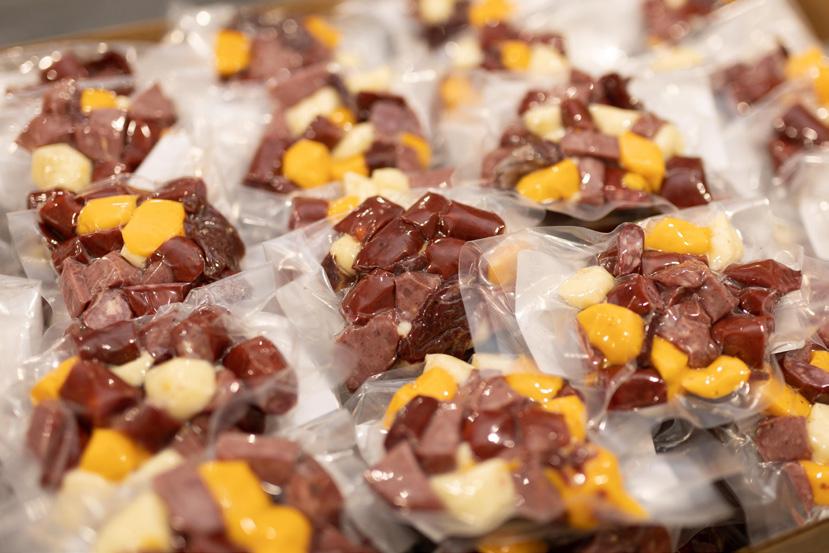
“We started our business by growing microgreens because they have a high turnaround rate, taking just two weeks to grow,” explains Krissy, who holds a degree in biology but admits they stumbled into the business of growing produce.

Calvin grew up on an acreage and always loved gardening with his father. With a passion for research and a desire to grow food on the couple’s acreage, he dove into learning every aspect of growing microgreens. Beyond the fast growing time, they typically boast 40 times the nutrition of their mature plant counterpart.

“Microgreens are perfect in salads, sandwiches and wraps,” Krissy says. “They are also great on top of avocado toast, pasta or stir-fry. No matter what food you’re enjoying, if you add a few microgreens, it will elevate the dish and add a huge boost in nutrition.”
Beyond co-owning and operating Cherry Lane Farm, Krissy runs the farmers market in Arnolds Park. Recently, Calvin and Krissy started a new business – Prairie Home Delivery – working with vendors from the farmers market to deliver fresh, high-quality foods right to consumers’ doors. The online store offers meat, produce, dairy, eggs, fruits, vegetables, spices and other products.
“We saw the need to include other producers and farmers to create an all-encompassing home delivery system,” she explains. “Supporting these local farmers and producers not only benefits their businesses but encourages them to continue to grow and make food.”
Owners Suzie and Chris Kraft attribute Ruthven Meat Processing's growth and expansion to the cohesiveness of their team and strong work ethic.
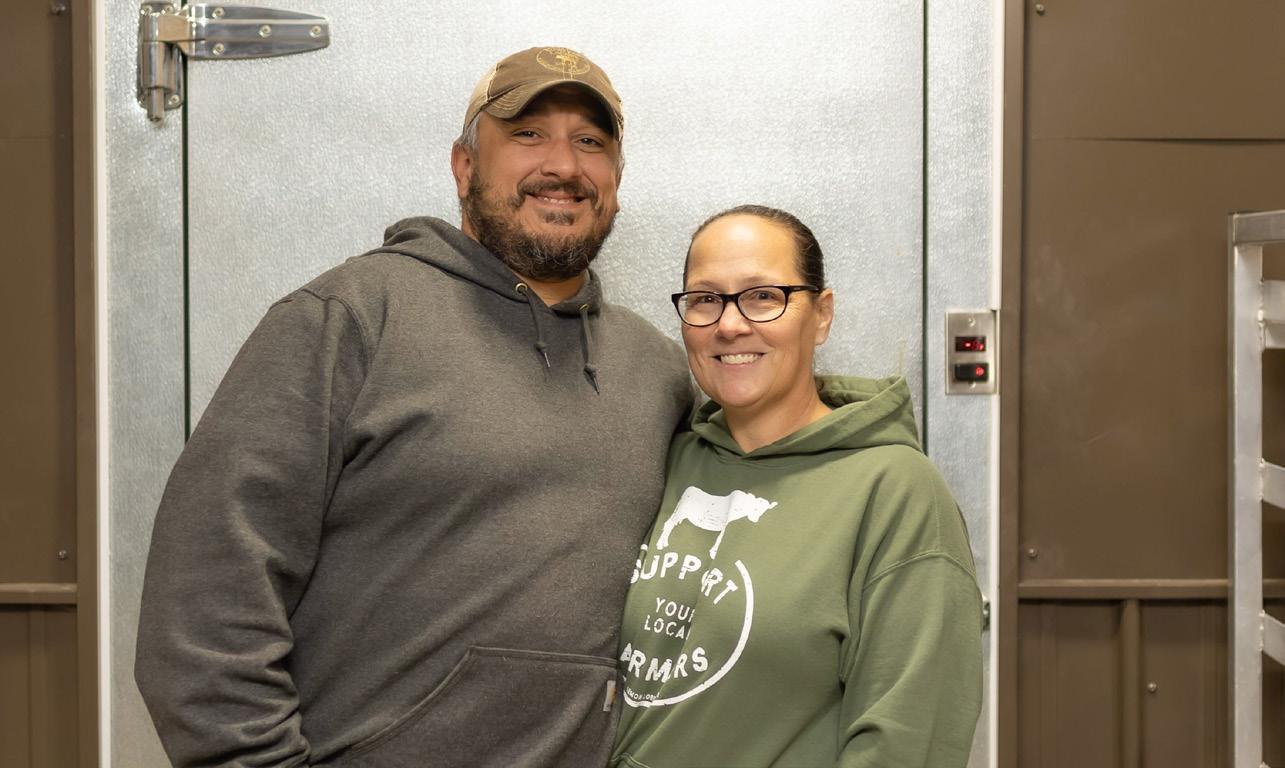
Slightly hidden just north of Ruthven’s giant grain silos, Ruthven Meat Processing is an iconic business serving the region with award-winning custom and retail meat. With dozens of awards from the Iowa Meat Processors Association and numerous Midwest honors, consumers value the exceptional quality provided by owners Chris and Suzie Kraft.
The company’s locker plant is located at the former building of the Farmers’ Creamery. The historical brick building presently housing the hub of Ruthven Meat Processing was long ago converted to a meat locker. Originally meat was stored in locked boxes within the facility’s large freezer; hence, the term “meat locker.”

Although the traditional lockers are gone from Ruthven Meat Processing, the Krafts provide custom-processed meats to thousands of satisfied customers. The business also features a line of quality fresh and award-winning smoked retail meats at four locations in the Iowa Lakes region.
“Most of our customers are from the local area because we are a licensed, state-inspected facility, which allows us to do custom processing,” Chris explains. “We do everything from whole hogs to quarters of beef, plus provide specialty meats at our retail stores.”
Suzie adds, “There is an increasing desire for consumers to know where their meat products originate. It’s fun to be able to highlight local farmers at our store.”
The Krafts are passionate about helping consumers understand more about labeling, country of origin and what to look for in fresh cuts. All this information is essential, Suzie says. The pandemic brought about changes for the business and created trends that continue to grow.
“During the pandemic, consumers became more aware of meat processing and discovered more ways to buy local products,” she explains.
“It’s easy to tell when it’s Iowa beef, for example, because of its rich red color, distinct marbling and texture, and wonderful taste.”



The perfect outdoor celebration, which includes broomball, flag football, soft football, bags tournament, chili cook-off, chocolate classics, polar plunge, fireworks and burning of the greens. This event lights up the atmosphere of the entire town.
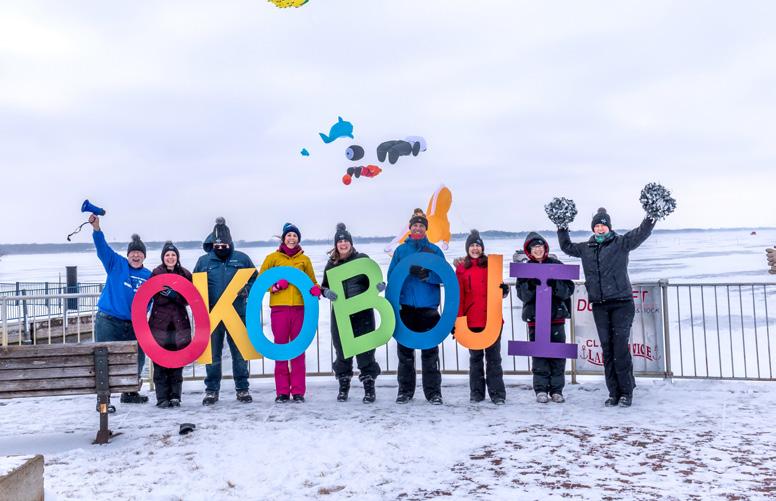



Fun is never weather-dependent! At King’s Pointe Resort in Storm Lake, below-zero days are no match for fast water slides like the Runaway Rebel and stress-free dips in the zero-depth entry pool. Ride inner tubes around the lazy river and enjoy the lily pad walk.
Eight Ranger Rick geocaches are set up throughout Kenue Park and Horseshoe Bend Wildlife Area in Dickinson County, and all visitors need is a smartphone with the geo app to find them. A passport is available at the Dickinson County Nature Center to mark off each geocache that is found.
The Scharnberg Park in Clay County is a perfect place to catch some trout. Be sure to get an Iowa fishing license, trout stamp and check out other Iowa lakes that are stocked with fish for the winter.
Fort Defiance State Park, near Estherville is 231 acres of wooded valley. During the summer it’s full of hiking paths and in the winter, it’s groomed with multiple paths for cross-country skiing and some paths for snowshoeing.
Additional opportunities for snowshoeing, crosscountry skiing, snowmobiling and hiking are abundant in the region. Check with county conservation offices for details.
Located in historic Arnolds Park, the museum provides visitors with an in-depth look at Iowa’s rockin’ roots through informative exhibits and artifacts from bands, musicians and radio personalities. The exhibits tell stories of the colorful personalities and pulsating rock and roll music that has shaped Iowa’s musical history.
Featuring vintage vehicles and an indoor display of “days gone by” of the Iowa Great Lakes, Arnolds Park and downtown Spencer. Along with a step back in time, visitors can get a glimpse of the state-of-the-art restoration shop that is set up with body, mechanical and interior trim departments.
» INDOOR
Numerous local art centers host quality and diverse exhibits each month, featuring national, regional and local artists. Each offers classes, gift galleries and special events throughout the year. Local art centers: Arts on Grand – Spencer, Pearson Lakes Art Center – Okoboji, Witter Gallery – Storm Lake, Kurio Kastle and A Piece of Work, Inc. – Spirit Lake.
» ESTHERVILLE METEORITE
On May 10, 1979, a 455-pound meteorite – the largest meteorite that has been known to have fallen in North America – fell to Earth in Emmet County, just a few miles north of Estherville. Portions of the meteorite are on display in Estherville, the Smithsonian Museum of Natural History and the Naturhistorisches Museum in Vienna, Austria.
Located in Storm Lake, this BBQ hot spot is home to the Hereford Burger and 2017 winner of Iowa’s Best Burger presented by the Iowa Beef Industry Council. Delicious food all starts at the farm with dedicated Iowans who raise the cattle.



The bakery, which has been part of downtown Spencer since 1916, has survived World War I, the Depression, the Great Fire of Spencer and World War II. Paul “The Baker” creates goodies that taste just like Grandma made. The bakers work through the night to have a large selection on hand every morning so patrons can fill up a box to take home or to the office.
A gorgeous and trendy little stop in Estherville features soups, salads, sandwiches, breakfast items and tons of home-baked items.
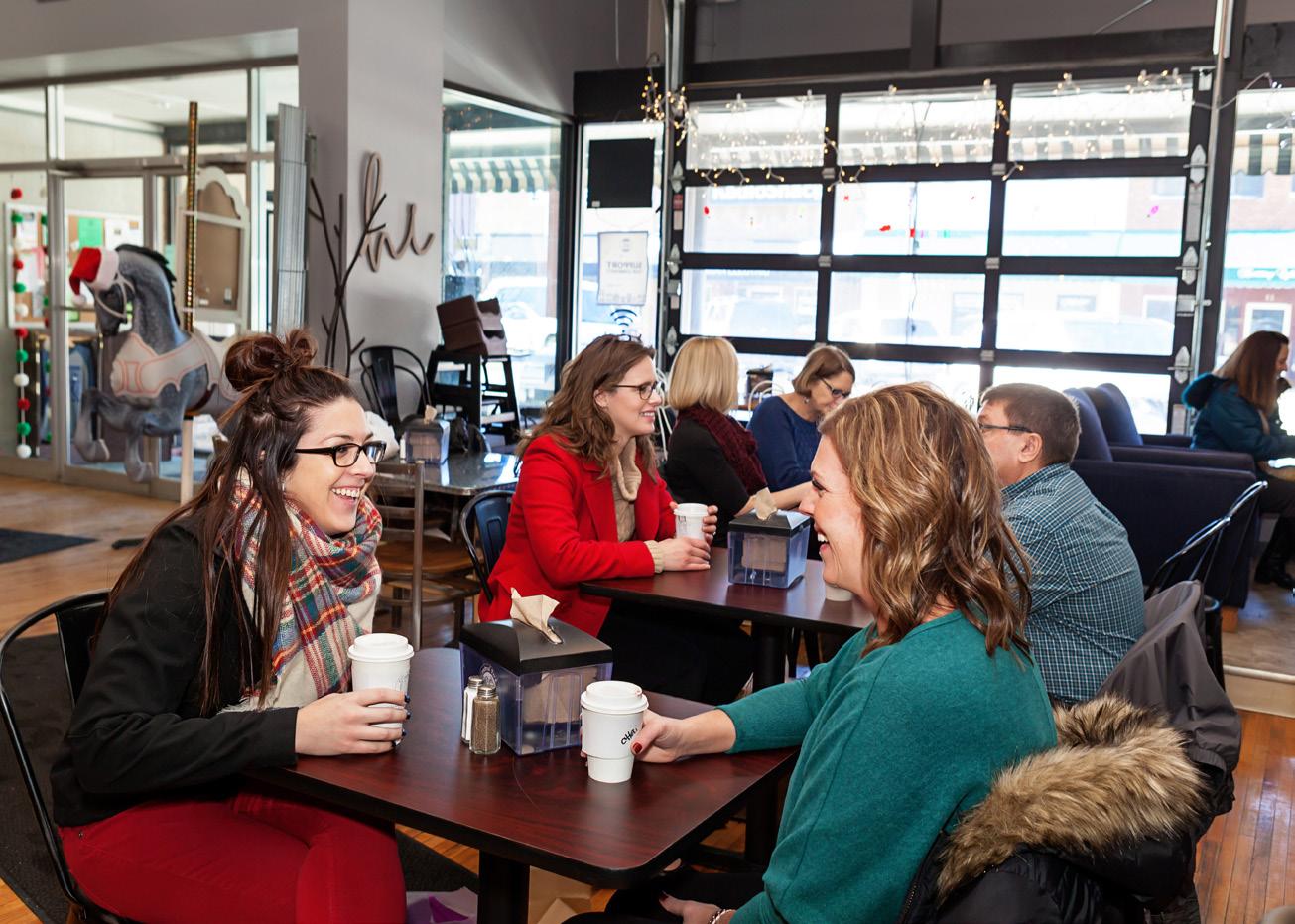

»

A seafood and steakhouse located in Arnolds Park, sources ingredients as much as possible from local farmers markets within a 90-mile radius. Owners Julianna and her husband Tom start most mornings in the kitchen hand-rolling meatballs, trimming meat and chopping vegetables for the day. The couple also owns Ciao Boji, an Italian and Mediterranean restaurant and wine bar in Arnolds Park.
Students learn plenty of lessons inside a classroom, but sometimes a broader perspective can be advantageous. Take teamwork and resiliency, for example. Students can learn about teamwork and resiliency through a book but experiencing them as part of a sports team or through extracurricular activities helps make the lesson more meaningful.
In the classroom or on the field, Iowa Farm Bureau invests in partnerships with the Iowa High School Athletic Association (IHSAA) and the Iowa Girls High
School Athletic Union (IGHSAU) to celebrate achievements in and out of the classroom.

“We seek to create a vibrant future for agriculture, our farm families and the communities in which we live,” says Craig Hill, a soybean, corn and pig farmer near Ackworth and immediate past president of Iowa’s largest general farm organization. “Iowa’s youth are vital to agriculture and Iowa’s communities.”
The student and athletic sponsorships mirror Iowa Farm Bureau’s mission, says Hill.
Iowa Farm Bureau celebrates students in all 99 counties in the state, representative of the makeup of the organization’s nearly 160,000 members.
The Governor’s Office, IHSAA, IGHSAU and its title sponsor – Iowa Farm Bureau – annually present the Governor’s Scholar Program. It recognizes nearly 400 of Iowa’s best students. Applicants aren’t required to be athletes to receive the recognition, though many are involved in athletics and activities outside of the classroom.
“Part of the partnership is linking the concept of the full student-athlete who is active in the classroom and focused on academics because it’s their path to the future,” says Chad Elsberry, IHSAA assistant director.
Recipients of the Governor’s Scholar recognition go beyond being good students. They’re also often involved in extra-curricular activities like fine arts and athletics, notes Elsberry.
Iowa Farm Bureau’s investment also recognizes student-athletes on the track, court, field and everywhere in between. Support of the girls’ and boys’ athletic associations provides funding for coaches’ clinics, preparing coaches with the tools they need to be effective role models for Iowa’s youth.

The partnership celebrates students’ efforts in their respective sports. Team plaques, championship balls, championship hats and team pictures are a few of the mementos Iowa Farm Bureau provides students and schools commemorating their achievements on the playing field.
“It’s a way to celebrate their accomplishments in the tournament and a reminder of the work they put in every day,” says Dana Ardary, marketing manager for Iowa Farm Bureau.

Hill is often seen presenting the awards to winning teams.
“It’s so gratifying to meet the kids and hand out the awards,” Hill says. “My son Adam played on a state basketball championship team, so I know how much it
means to the student-athlete, family and community. It’s a great opportunity for us to celebrate hard work and outstanding achievements.”
Noting the achievement of the Governor’s Scholar Program recipients and their efforts outside of the classroom, Hill says recognizing student-athletes is a double reward.
“When you recognize an individual’s athletic achievements, you know they’re probably also striving to be a good student,” he says.
In 2018, Iowa Farm Bureau expanded its support of studentathletes by providing no-cost concussion insurance coverage for student-athletes.

The HeadStrong Concussion Insurance program covers all male and female students in grades 9 to 12 participating in practice or events sanctioned by the IHSAA and IGHSAU.
“The well-being of our youth is important,” Hill says. “Providing concussion insurance helps alleviate some of the health and financial concerns of coaches, parents and participants.”
The provided coverage is another element of Iowa Farm Bureau’s commitment to Iowa’s youth and communities, Elsberry says.
“Iowa Farm Bureau has made a tremendous commitment and investment in Iowa communities and schools,” Elsberry says. “We value it very much, knowing it helps serve the whole student – the student in the classroom and the student involved in activities.”
Iowa Farm Bureau works for Iowa’s farm families, but its work reaches well beyond the farm – benefiting Iowans in all walks of life. Iowa Farm Bureau was started in 1918. Back then, farmers, teachers, bankers, chamber of commerce officials and other community leaders joined forces to support a way of life and an economic driver that benefited them all: agriculture.



 By Darcy Dougherty Maulsby
A welder creates metal bulbs outside of Victor.
By Darcy Dougherty Maulsby
A welder creates metal bulbs outside of Victor.
“I

tsy Bitsy Spider” is a fun children’s song, but it’s quite the opposite with the colossal yard art at Randy and AJ Schnebbe’s farm near Victor.
“A field rock makes the body of the spider, and each leg weighs about 90 pounds,” says Randy, a farmer and owner of RS Welding Studio, which has gained a loyal following at the Des Moines Downtown Farmers’ Market and other venues.

While Randy can design largerthan-life artwork, most of his creations fit easily in a garden. They range from whimsical ants and caterpillars made of rocks
and iron to metal topiaries, trellises, benches and more.
An innovative entrepreneur with a creative spirit, Randy never intended to become a metal artist. He grew up on a farm near the Amana Colonies and studied farm operations at Iowa State University. After college, he moved to his grandmother’s farmstead near Victor, where he raised corn, soybeans, cattle and hogs. By the early 1990s, he needed more income to support his “farming habit.”
Following a trip to a hay auction, Randy got connected with an Amish craftsman who made roll-
top desks, dining room tables and other fine furniture. Randy started selling the furniture through Amish Creations, which he founded in 1993. “Then we found another Amish man who made lawn furniture, and that sold really well,” says Randy, who began offering these items at lawn and garden shows around Iowa.
Randy decided to expand his product line by selling Mexican yard art, but there was a problem. “It’s not high quality, and you’re lucky if you get three years out of it,” says Randy, who often had to weld and repair these items. “I told my wife, ‘I can do better.’”
Art of metal, iron and rocks is available for purchase in RS Welding’s gift shop.
Around this time, Randy and his wife AJ attended a lawn and garden show in Cedar Rapids, where they met a vendor from Oklahoma who made yard art. While the man was a competitor, he showed Randy a few tricks of the trade and made some custom tools for him before he retired. “That was one of the best things that ever happened to us,” says Randy, who has been dubbed the “Grant Wood of yard art.”
Before long, Randy went from a full-time farmer to a parttime farmer and metal artist. Through the years, he and AJ have developed an array of products, including bicycle-themed items, home décor, items with logos from Iowa universities, triangular

metal Christmas trees and Christmas ornaments that can be customized with a wreath, ribbons and more at the point of purchase.
As the Schnebbe’s business has grown, so has their team, which includes part-time welders Emily Riedel and Haley Voigtman. Their craftsmanship has led to some custom projects, thanks to connections made at the Des Moines Downtown Farmers’ Market and other venues.
One of Randy’s designs (double eagles in a double circle) was sent to the Pentagon. Another one of Randy’s favorite projects, a 9.5foot metal tree, evolved after the client saw his work at a national Pheasants Forever convention in Des Moines.
The tree is displayed in the
lobby of Scag Power Equipment in Mayville, Wisconsin. “This company makes the ‘Cadillac’ of commercial lawn mowers,” Randy says. The employees commissioned Randy to build a huge metal legacy tree as a gift to the company’s owner. The tree’s leaves feature words like “kind,” “friendly” and “godly,” which describe the company’s owner.
“It took nine months to complete this project,” says AJ, who handles marketing and more for RS Welding Studio.
A willingness to try new things helps the Schnebbes adapt to changing times. In 2021, they debuted Homegrown Grace, a market at their farm.
Randy Schnebbe in his welding studio.Named after the couple’s collegeage daughter, Meredith Grace, Homegrown Grace was held on the second Saturday of each month from May through September. Up to 500 people attended each event, including 30 to 40 vendors, food trucks and more. “It was great to see all the smiles and hear people visiting,” Randy says.
Along with their metal art, the Schnebbe family sells their popular Got Dough products. In 2017, AJ developed this edible, chocolate-chunk cookie dough (which local “dough divas” package in the kitchen at the Victor city hall) after returning from a show where people waited in line for funnel cakes – the only snack available.
Got Dough, which contains heat-treated flour and no eggs, has been a big hit as a fundraiser for 4-H clubs, high school show choirs and other organizations. “We like to help out local communities,” AJ says.
The Schnebbes appreciate the customers and employees who have helped RS Welding Studio and Got Dough to thrive. “When you support a small business, you’re supporting a family,” AJ says.
It’s hard to say where the family’s entrepreneurial spirit will take them next. Randy adds, “It’s unreal how this business has grown.”
Win a $100 gift card to RS Welding Studio to purchase a “Handcrafted in the Heartland” item. Visit iowafoodandfamily.com/ magazine/rsweldingstudio and enter to win.






 RS Welding has a variety of art pieces for every taste and style.
Linda Jack, decorator at RS Welding, prepares items for sale.
RS Welding has a variety of art pieces for every taste and style.
Linda Jack, decorator at RS Welding, prepares items for sale.
Sara Preston is a sixthgeneration farmer who raises cattle and grows corn and soybeans. She is an active member of CommonGround Iowa and is an educator with North Central Iowa Ag in the Classroom. She grew up in the agriculture industry with a foundation in the 4-H and FFA Youth Leadership programs. Sara lives near Swea City with her husband Jared and children Nora, Maggie and Croix.

The word sustainability is a frequently referenced term, but to many can be confusing and questionable. What does sustainability in agriculture mean? Is it something that farmers take seriously?
Sustainability is the act of protecting the environment in many ways, including soil health, water conservation, pollution control and energy reduction. So, the next question is, do farmers care about sustainability? The answer is: absolutely!
On my husband’s family farm, we are raising the fifth generation. We are blessed to have four of those five generations still around the farming operation, including Jared’s almost 90-yearold grandmother. The neat part of family farms is that we are still farming the land that Jared’s great grandparents farmed. We understand and know firsthand the decisions we make don’t just impact us and next year’s crop but will ultimately impact our children or grandchildren if they choose to farm in the future. No pressure, right?
Soil health is essential for crop farmers so we continually monitor and evaluate it. Like
many farmers across the state, we are planting more cover crops. We plant winter rye in the late summer on the fields we chopped for corn silage, then let that grow through the fall, winter and spring. We cut or chop the rye in late spring and feed it to our cattle. We plant soybeans on those fields for the remainder of the growing season.
Cover crops provide another feed source for our livestock while benefitting the land. The plants protect the topsoil from the wind and other winter elements. This minimizes erosion, keeping vital nutrients in the soil. This practice also means we need less fertilizer on crops during the growing season because many critical nutrients, which plants need to thrive, have stayed in place.
Plant researchers and breeders also help crop farmers with sustainability. During this past summer, we experienced a drought with minimal rainfall from the time we planted corn and soybeans until harvest. We were pleasantly surprised how well these crops tolerated the drought and were still able to produce a good yield. Thanks to researchers and plant breeding, we have plants that can withstand different elements.
As livestock farmers, we are very mindful of the environment. In northern Iowa, pastureland is hard to come by, so some of our cow/calf pairs and feedlot cattle are raised in hoop barns. This is a way we can effectively raise cattle without overrunning pastureland.
Cattlemen across the state work extremely hard to ensure their cattle are helping the land. We have seen this hard work pay off. Research shows that between 1960 and 2018, beef producers reduced their carbon footprint by 40% while producing 66% more beef. Breeding and nutrition
benefit farmers as we can raise beef cattle more efficiently by having our animals grow at a quicker but healthy rate. We now have the genetic knowledge at our fingertips to pick cows and bulls that will produce a calf who will grow quicker than others, making safe, high-quality beef more readily available.
Another way our farm practices sustainability is by selling most of the corn we don’t feed to our cattle to a local ethanol plant. It processes the corn into a renewable fuel. By selling corn and soybeans into renewable fuels, we reduce greenhouse emissions every year. Renewable

fuels have helped take the equivalent of 18 million cars off the road since 2008.
Our farm family, together with farmers and ranchers across the country, work hard to be the best in the world when it comes to producing safe, wholesome and high-quality products with the smallest environmental footprint possible. This is something farmers and the agriculture community work toward daily and will continue to work on for years to come. Farmers know the impact their decisions have and work tirelessly to make the best choices today and for future generations.
We understand and know the decisions we make don’t just impact us but will ultimately impact our children and grandchildren.Winter rye – a cover crop – helps keep valuable nutrients in the soil.
